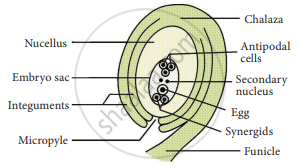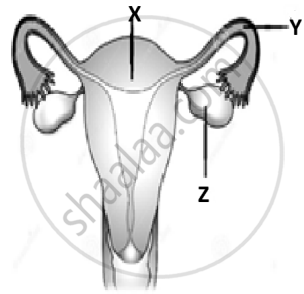Advertisements
Advertisements
Question
A neat labelled diagram describes the parts of a typical angiospermic ovule.
Solution
The main part of the ovule is the nucellus which is enclosed by two integuments, leaving an opening called the micropyle. The ovule is attached to the ovary wall by a stalk, called funiculus. The basal part is Chalaza.

Structure of an Ovule
The embryo sac contains seven cells and the eighth nuclei located within the nucellus. Three cells at the micropylar end form the egg apparatus and the three cells at the chalazalnte9uments end are the antipodal cells. The remaining two nuclei are called polar nuclei found in the centre. In the egg apparatus, one is the egg cell (female gamete) and the remaining two cells are the synergids.
APPEARS IN
RELATED QUESTIONS
Rewrite the terms in the correct order so as to be in a logical sequence.
Graafian follicle, ostium, uterus, fallopian tube.
Name the following:
The parts of the ovary containing mature ovum.
Give Technical Term:
What term is used for the arrest of reproductive capacity in females?
Hormones secreted by the ovary of the female reproductive system.
The implantation of the embryo occurs at about ______ days of fertilization.
Which one the following is a part of external genitalia of a female human being?
Bartholin’s glands are situated ______.
Figure A shows the front view of the human female reproductive system and Figure B shows the development of a fertilized human egg cell
Figure A

Figure B

Identify the correct stage of development of the human embryo (Figure B) that takes place at the sites X, Y, and Z respectively in the human female reproductive system (Figure A).
Choose the correct option from the table below:
| X | Y | Z | |
| A | Morula | Fertilized egg | Blastocyst |
| B | Unfertilized egg | Fertilized egg | Morula |
| C | Blastocyst | Fertilized egg | Unfertilized egg |
| D | Fertilized egg | Morula | Blastocyst |
Read the following and answer from given below:
During copulation, semen is released by the penis into the vegina. The motile sperms swim rapidly, fuse with the ovum in the ampullary region, resulting in fertilization. The haploid nucleus of sperm fuses with that of the ovum to form a diploid zygote.
Select the correct sequence of various physical and chemical events that take place during fertilisation.
P. Fusion of cortical granules with the plasma membrane of secondary oocyte.
Q. Formation of fertilization cone to receive sperm.
R. Release of sperm lysin from acrosome.
S. Mixing up of chromosomes of a sperm and an ovum.
In human beings, the correct sequence of events during reproduction is
